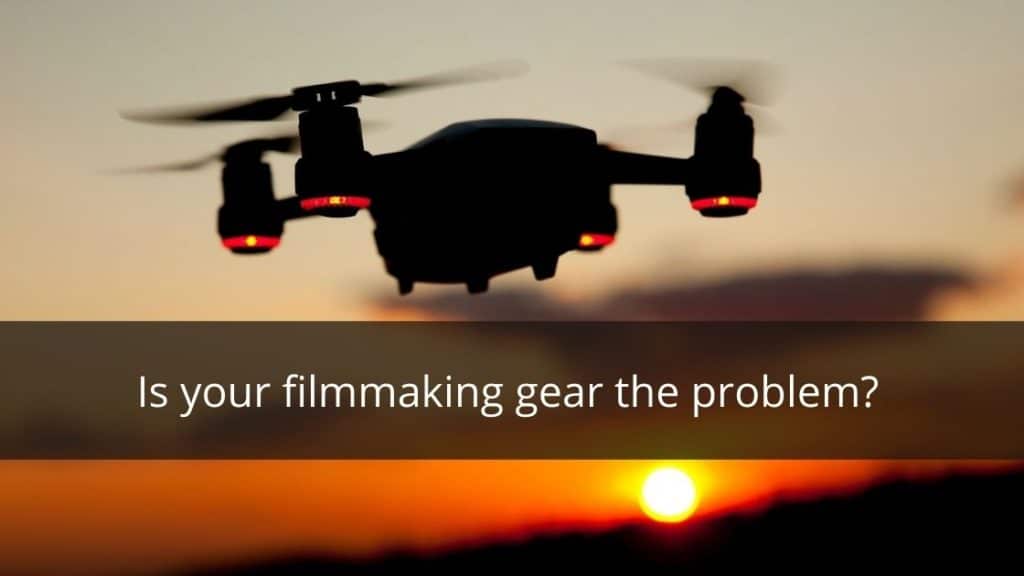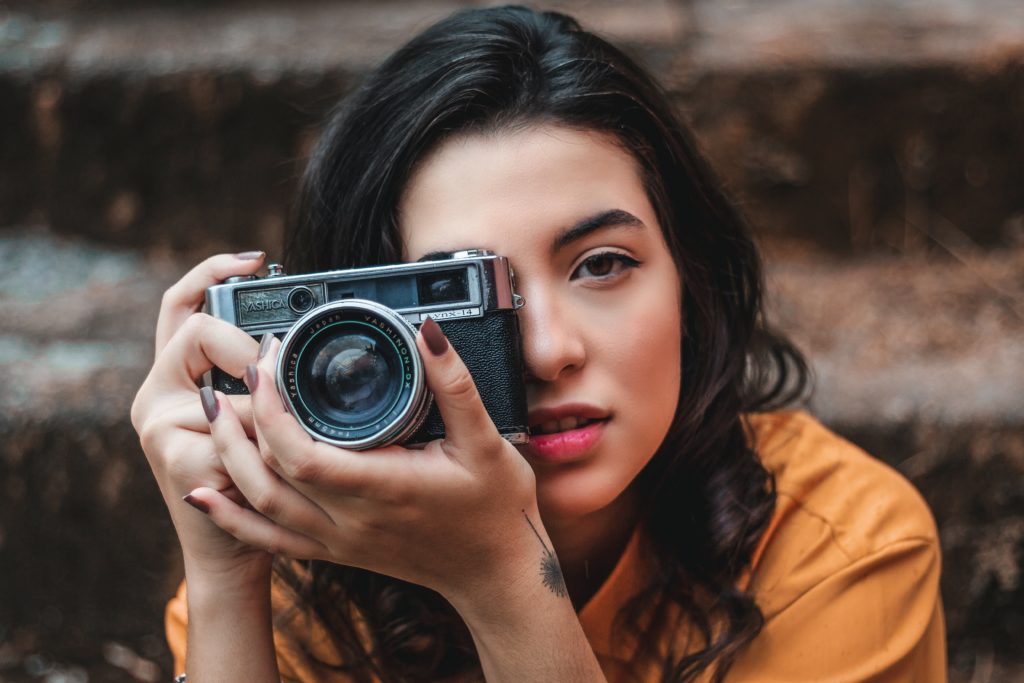Article by Colette Nichol, Solo Filmmaker and Story Strategist
Estimated reading time: 7 minutes

Are your filmmaking tools and gear the problem?
Do you need to upgrade your gear yesterday?
Maybe. We’ll find out. In a minute, I’m going to walk you through the process of figuring out whether the problem is YOU or your TOOLs.
But first, let’s dig into metaphor land.
Storytime:
Every morning I make a single cup of pour-over coffee.
It’s a ritual. Yes, I love the coffee. But I also find the anal-retentive routine to be therapeutic. It’s probably a control thing.
Either way, it runs in the family.
I grew up in a family of “fusspots.”
That’s what my dad calls it. My parents ran a vineyard and farm winery for 17 years. The reason it was successful is that my mum is a business boss and my dad is a fusspot.

To make great wine, my parents had to scrimp and save on the tools that weren’t that vital, and then put all their energy into the areas that actually affected quality. That means they used old milk tanks (yes, they were clean) as fermentation vats instead of brand spanking new purpose-built tanks.
It also meant they were meticulous about their viticultural practices.
My mom did not mess around with grape growing. They were the first in the valley to use the Geneva Double Curtain system of vine training. (Sounds pretty pro, right?)
They were the first to grow Syrah in all of Canada. If you think shopping on December 24th is hair raising, try taming the growth of our Syrah plants in August—they were a nightmare of tangled tendrils.
There were things mattered when it came to quality.

Having our own high-tech labelling machine didn’t matter. We labelled those bottles by hand for years.
Having the sexiest wine shop definitely didn’t matter. My parents sold wine out of an upgraded garage for YEARS. And they still got their wine into the best restaurants in Vancouver.
But spending long hours tending the vines to get the absolute best quality of grapes…this mattered quite a bit. Just as my dad’s finicky wine-making process mattered.
What does this have to do with filmmaking?
Just like my parents only spent time and money on the stuff that mattered, we should do the same with our filmmaking gear.
#1 Filmmaking Success Rule:
Only spend money on the things that matter. Only dedicate your time to the things that matter.
There are a lot of people on YouTube whose channels seem solely dedicated to making you want the latest gear. But if that gear isn’t going to make your videos better, then what’s the point?
In filmmaking, there are times when you do need to upgrade your gear.
When the gear truly is the problem. And there are times when the user needs to upgrade their skills.
Here are a few times when the filmmaking gear IS the problem, and you shouldn’t feel bad about lame results:
1. Starter cameras are notoriously difficult to use.
Ironic, isn’t it?
But you’ll get better results more quickly and easily from the Canon 90D ($1500) than the Canon T7i ($800). While I’m not saying you need to rush out and get a new camera right away, I am saying that you shouldn’t feel too bad if you’re struggling. And it remains to be seen how the Canon T8i handles. Perhaps things will change.
But often you’re better off using your cell phone camera until you can upgrade to something better.
2. Old bulky tripods. These are the worst!
You’re bound to feel incompetent if you’re using one of these.
Hate your tripod? Definitely, find one you like. Just know, it takes about 5-10 hang-out sessions with your tripod to get used to it. A newer yet still affordable tripod is much likely to get used over and over again—and thus give you good results.
3. Cameras without focus peaking!
Focus peaking in-camera means you’ll see little dots on the screen where the image is in focus.

If you’re filming fast-moving scenes like, say, a soccer match or a dance show, this is vital. If you’re shooting mostly interviews and slower-moving scenes, you’re all good at using the Optical Zoom to grab focus.
You can buy a small external monitor if you need focus peaking for 50% of your shoots – or just rent one if it’s a now-and-then situation.
4. Kit lenses with a max aperture of f/5.6.
If your kit lens has a fixed or variable aperture that doesn’t open wider than f/5.6 you’re going to have serious trouble filming inside in low light.
It is going to be a pain. A mega pain, in fact.
It’s not you; it’s the lens!
If you’re shooting indoors in low light, you’re probably going to need a minimum of f/2.0 to get the shot without tons of grain. Or, well, you’re going to need lighting.
5. Newbie lighting setups that cost under $150.
Starter lighting kits are known for giving dubious skin tones.
If you’re struggling with lighting, and you’re using an Amazon lighting kit that gave you three lights for $150, don’t feel bad. When it comes to lighting, I err on the side of buying one great light, rather than three crappy lights. It’s impossible to get beautiful skin tones with your lights if they have a low CRI rating. (CRI means Colour Rendition Index, and you’ll want it to be ABOVE 95 when buying lights.)
Some Gear is Transformational
Some gear will make a huge difference.
It will truly transform your work. Other gear won’t make much of a difference at all.
As you continue your filmmaking journey, don’t get sucked into the hype around gear. Don’t become a gearhead. Being a gearhead won’t help you become a better filmmaker.
Instead, become a fusspot.
Fuss over the things that matter.
Spend your time (and money) on the tools and techniques that move the needle towards better quality.
Back to Coffee for a Second
When it comes to my morning coffee, three things make all the difference.

- Preheating my cup with boiling water (totally free).
- The hipster pour-over kettle with the long thin spout (very cheap).
- The high-quality beans that I grind fresh each day (worth every penny!?)
So what about filmmaking gear? What matters?
What filmmaking gear really matters when it comes to making good films and videos? And which gear will truly affect the quality of your final product?
- The lens will affect the quality of the footage more than the camera, in most cases. Lenses are also “good for life.” They’re made of glass and metal with a little bit of plastic. Good lenses don’t lose value the way that cameras do.
- Having a fast computer that makes video editing pleasant is worth every penny.
- Having a good mouse that prevents your hands from hurting when editing is important.
- Your tripod is critical. Stabilizing your footage is of utmost importance.
So what’s the takeaway?
Sometimes it’s you, and sometimes the problem is your gear.
Before you assume it’s one or the other, take a minute. Sit down and analyze the issues you’re having with the footage. Is it user error or are you using gear that’s overly complex, difficult or poorly made?
Learn Filmmaking and Get the Gear Guide
If you’re interested in learning filmmaking, check out the Solo Filmmaking Mentorship Program I created for aspiring filmmakers and video creators. It usually goes live once per year. So I recommend getting the Story Envelope Filmmaking letter which comes out a couple of times per month. That way, you can get filmmaking tips for free and find out when the filmmaking course is going live again.
Also, before you go, grab the Solo Filmmaking Gear Guide and Checklist for Beginners.

About the Author
Hi! I’m Colette Nichol. I’m a solo filmmaker and story strategist based out of rainy Vancouver, Canada. I’ve been making videos and micro films for small businesses and global brands since 2014.
Plus, I LOVE to help aspiring filmmakers pursue their dreams and start making films. This blog is designed to help you gain the knowledge you need to become a filmmaker.
If you want more, get on the waitlist for the Story Envelope Academy Solo Filmmaking Mentorship Program. It opens up one time per year and is the best way to become a filmmaking or video pro fast!
CLICK HERE to get on the solo filmmaking mentorship waitlist.